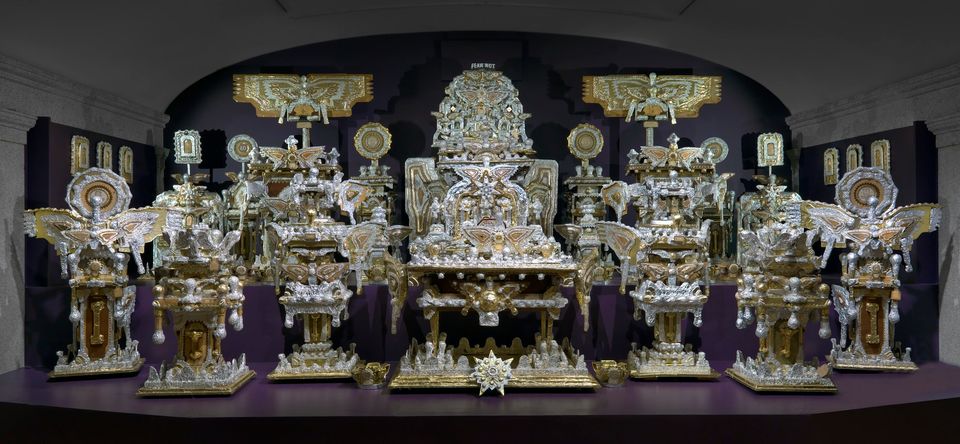Martín Ramírez
- Also known as
- Martin Ramirez
- Born
- Jalisco, Mexico
- Died
- Auburn, California, United States
- Active in
- Sacramento, California, United States
- Biography
Ramírez left Mexico as a young man to seek employment in the United States. He worked for a short time with railway construction crews, but was soon unable to cope with the pressures of his new life in California and was diagnosed as paranoid schizophrenic. Ramírez spent the remainder of his life in California mental hospitals. After 1940, while institutionalized at the DeWitt State Hospital near Sacramento, he assembled his memories on pieces of scrap paper, pasted together with improvised adhesives, and drew his precise, dense, and repetitive marks and shapes with scavenged pencils, crayons, and markers.
The art of Martin Ramírez presents a world of patterns and repetitions based on cultural iconography and personal, idiosyncratic symbols. In this drawing, [Untitled (Church), SAAM, 1986.65.192] the symmetrical structures of a Baroque church recall buildings undoubtedly familiar to him from his native Mexico. The towers, façade, central domes surmounted by crosses, and the roofed arcade are all common elements in Spanish Colonial and Mexican mission architecture. The dark, arched doorway recalls the tunnel imagery that Ramírez repeated in many of his approximately three hundred drawings.
Lynda Roscoe Hartigan Made with Passion: The Hemphill Folk Art Collection in the National Museum of American Art (Washington, D.C. and London: National Museum of American Art with the Smithsonian Institution Press, 1990)
- Artist Biography
Martín Ramírez came to the United States from Mexico as a young man. His physical frailty, as well as the shock caused by a new culture and language, led to his eventual mental breakdown. In 1930 he was placed in an institution, where he remained until his death in 1960.
Around 1948, Ramírez began to draw on an eclectic array of paper surfaces—brown wrapping paper, laundry lists, paper cups, old letters—which were glued together to form a unified drawing area. He made use of a variety of tools and techniques, including crayons, colored pencils, watercolors, chalk, ink, and collage.
Ramírez's motifs reflect his life in two distinct cultures. His highly patterned, intricate drawings present fantastic renditions of subjects such as Mexican soldiers, Madonnas, prairie dogs, cars, and trains. In terms of technique, what is most extraordinary in Ramírez's art is his use of line to create the many different kinds of space—niches, frames, stages—in which his protagonists are placed. Although flatness characterizes the overall effect of his technique, the numerous parallel lines in Ramírez's work bring about a sense of visual depth.
In Soldado with American Flag, [SAAM, 1986.65.194] the action takes place, as in many related Ramírez drawings, on what can be described as a stage. Directly below the soldier on horseback, who holds center stage, is another drawing in which two animals are portrayed inside a similarly constructed stage. Although Ramírez's central image has a wonderful and playful quality, the proximity of the two seemingly unrelated scenes lends the work an air of potent mystery.
Hispanic-American Art (brochure, Washington, D.C.: National Museum of American Art)















